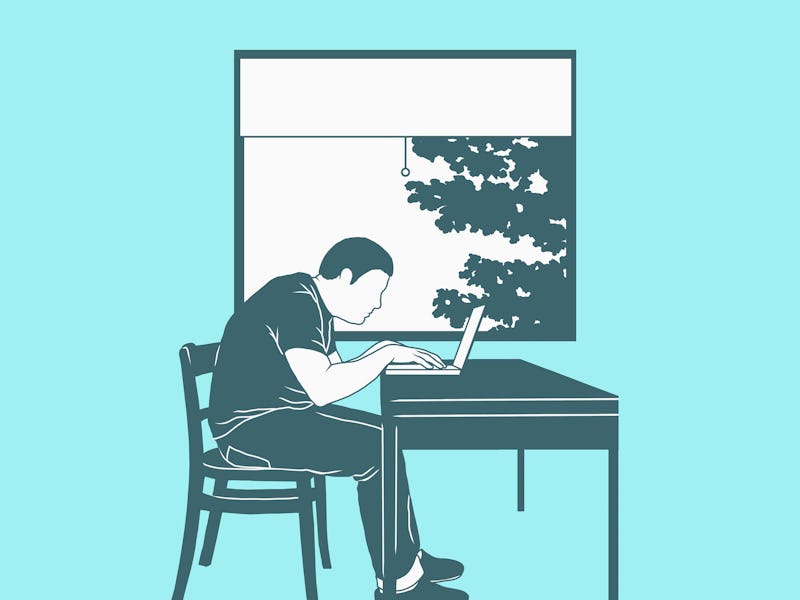5 strategies to stop sitting and get moving while stuck at home
"Find something that makes you want to move."

Sitting for over six hours for days at a time can cause some pretty terrible effects, ranging from high blood pressure to even higher risk of death. Yet, as we face weeks in lockdown and the work-home divide erodes, we seem to be sitting a whole lot more.
It's a habit that threatens our health. Luckily, experts say that are concrete steps we can take to avoid remote working repercussions and get off our bums while social distancing.
David Rogerson is a sports nutritionist and lecturer at Sheffield Hallam University. He recommends that people schedule "movement breaks" throughout the day, find an activity they love, stretch, eat intentionally, and simply move more.
“Prolonged sitting can be a real problem,” Rogerson tells Inverse. “It can create cardio-metabolic problems and create issues with blood glucose levels or insulin levels, and heart health, and disease risk. Breaking up prolonged sitting is really important.”
5. Schedule “movement breaks” every hour
On a regular day, people end up hustling by accident, whether they are trying to catch a bus or walk to lunch. Removing spontaneous activity from the day can have a “real impact” on how much energy we burn daily and our overall health, Rogerson says.
To avoid sinking into a sedentary lifestyle, set a timer once an hour to remind you to move, Rogerson advises.
Get up, walk away from the laptop, and move your body, he says. This can be as simple as walking up and down the stairs, taking a loop around the block, or simply standing.
“The movement needs to be fairly active and it needs to get you slightly out of breath,” Rogerson says.
"If you take structured movement breaks, what you'll find is that you'll feel better about your work. You might also be more productive, and it's gonna have a 'knock-on effect' in potentially improving your health."
4. Find an activity you love
Social distancing has triggered waves of social media posts explaining how you can stay fit during the lockdown. Influencers and regular users now share their runs, dance workouts, and HIIT sequences constantly.
These posts can be motivating, but they can also cause unintended, negative effects — causing some to feel excluded, or feel like they can't keep up, Rogerson says.
Instead of following the crowd, find an activity that makes you want to move, Rogerson says.
It's crucial you choose an activity you want to do — not an activity you think you should be doing.
"I think most people find that there is some form of movement that they actually enjoy," Rogerson explains. It doesn't necessarily have to be Orange Theory in your living room. It could be walking the dog, doing pilates, or playing in the back garden.
"Find the thing that you enjoy and the thing that you get intrinsic value from and do that," Rogerson says.
3. Avoid pain points and stretch
Sitting all day long can seriously screw up our posture, eventually driving lower back and shoulder pain. Overdoing it on the laptop can also cause carpal tunnel and strain the wrists. To address these issues, Rogerson suggests revamping your work environment: To do this, make your desk and chair the appropriate height and don't slump.
Rounding your back and stretching your spine can keep back pain at bay.
If you start to feel uncomfortable, you can do a Child’s Pose, touch your toes, or hug your knees while lying on your back. These movements stretch the spine and provide some relief.
Opening up your chest can also reverse some of the side effects of slumping. Rogerson advises arching your back or using a foam roller to open up locked-up shoulders, chest and neck.
Strengthening the core and glutes, with bridges, lunges or squats, will also help support you if you’re spending too much time sitting and less time moving, Rogerson says.
2. Eat intentionally
Work environments can often facilitate healthier eating habits, Rogerson says. When you’re getting up and going into the office, mealtimes can be more structured and you may be inclined to choose healthier foods. At home, it's tempting to graze on empty-nutrient snacks.
Maintaining that eating structure will benefit you physically and mentally as you work from home, Rogerson advises. This means lots of fruits and vegetables, whole grains, and nutrient-rich foods.
1. Just move more
People typically see exercise as a workout in the morning or at the end of the day. Rogerson reminds "it's not."
Physical activity is cumulative, he points out. A HIIT workout or yoga session is a great way to sweat, but people shouldn’t underestimate how quick hits of spontaneous activity throughout the day can lead to major health gains.
If you are a religious exerciser — never missing a morning gym session or afternoon run — you should still incorporate basic movement throughout the rest of the day, Rogerson says. One single workout can't counteract a day of being sedentary.
"Any activity is helpful," he explains. "But the research is fairly unequivocal in suggesting that regular physical activity throughout the day is important."
Being active also boosts mood and can contribute to positive mental health. A 2019 study found that adding an additional 35 minutes of exercise into your day can lower the risk of depression and improve resilience — which is pretty much exactly what we need just about now.